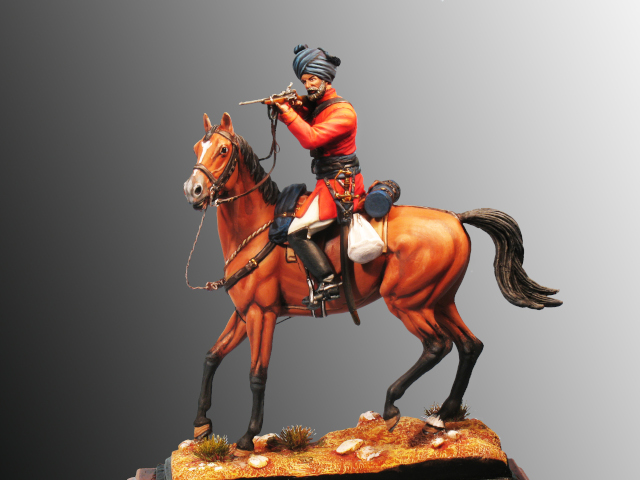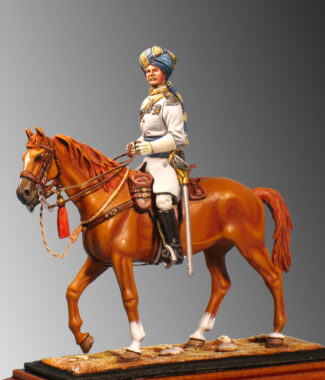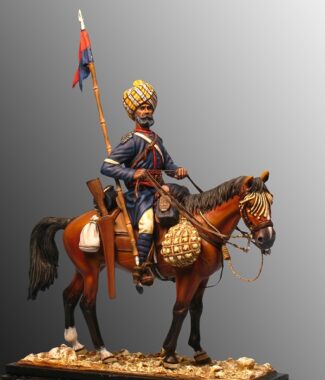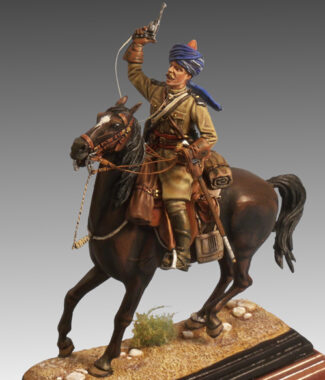You must be logged in to post a review.
2nd Regiment of Cavalry, Punjab Frontier Force – 1870
€68.00
Figure to assemble and paint
Ref.: 21 – IA
Weight: 150 grs.
Material: White metal
Number of Pieces: 16
Historical Review:
Raised in 1849 as 2nd Punjab Irregular Cavalry in 1849
-
- 1851 – 2nd Regiment of Cavalry, Punjab Irregular Force.
- 1865 – 2nd Regiment of Cavalry, Punjab Frontier Force.
- 1901 – 2nd Punjab Cavalry in 1901.
- 1903 – 22nd Cavalry (Frontier Force) in 1903.
- 1904 – Sam Browne`s Cavalry (Frontier Force) in 1904.
After the reforms of 1921, Sam Browne’s 22nd Cavalry merged with the 25th Cavalry (Frontier Force) and was renamed the 12th Cavalry.
In 1937, the 12th Cavalry Regiment became the training regiment for the 2nd Indian Cavalry Group in Ferozepur. In 1940, it became a permanent training centre when it merged with the 15th Lancers Regiment.
aftwer the partition of India in 1947, this training centre was transferred to Pakistan. On 15 January 1955, the 12th Cavalry Regiment (Frontier Force) was reorganised in Rawalpindi as the Reconnaissance Regiment of the Pakistan Armoured Corps.
Battle Honours: Delhi, Lucknow, Ahmed Khel, Afghanistan 1878-80, Mesopotamia (World War I)
Composition (1901): Sikhs, Hindustani Hindus, Hindustani Muhammadans Punjabi Muhammadans, Pathans.
The 2nd Punjab Irregular Cavalry Regiment was a British cavalry unit in India. It was created as the 2nd Punjab Irregular Cavalry in Lahore in 1849 by Lieutenant Samuel J. Browne of the British East India Company. This regiment was one of five Punjab Cavalry regiments formed with the aim of protecting India’s north-western frontier. It became famous as part of the Piffers(1) or the Punjab Frontier Force.
The regiment served on the north-western frontier of India during the following years. It had previously participated in the Indian Rebellion, also known as the Sepoy Mutiny, in 1857. Its troops took part in the siege of Delhi and the relief of Lucknow. Later, the unit fought in the Battle of Agra and also participated in the Rohilkhand campaign. Captain Sam Browne, one of the commanding officers, was awarded the Victoria Cross for the regiment’s distinguished service. Captain Dighton Probyn was also awarded the Victoria Cross during his service in this regiment.
Military personnel from the 2nd Punjab Cavalry Regiment joined the Kandahar Field Force during the Second Anglo-Afghan War between 1878 and 1880. The military unit also actively participated in the Battle of Ahmad Khel in 1880. In addition, it rendered valuable military service during the First World War and took part in the Mesopotamian campaign.
The figure fires the Snider Enfield cavalry carbine. This rifle was designed as a temporary solution for the British army in the late 19th century. It was a transitional rifle with a higher rate of fire than the Enfield Pattern 1853 musket. Eventually, it would be replaced by the Martini Henry. The Snider-Enfield in the figure is the MkIII model used by the cavalry. It fired .577 calibre black powder cartridges. It was used by the British Indian Army until the late 19th century.
NOTE (1)
‘Piffers’ refers to a term used to designate the regiments of the Pakistan Army’s Frontier Force. These regiments have a long military history, originally as part of the Punjab Irregular Force (PIF) of the British Indian Army. They are popularly known as ‘Piffers’ because of this history as PIF or FF (Frontier Force).








Reviews
There are no reviews yet.